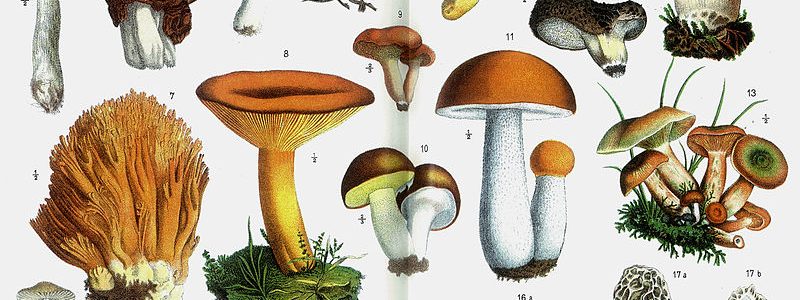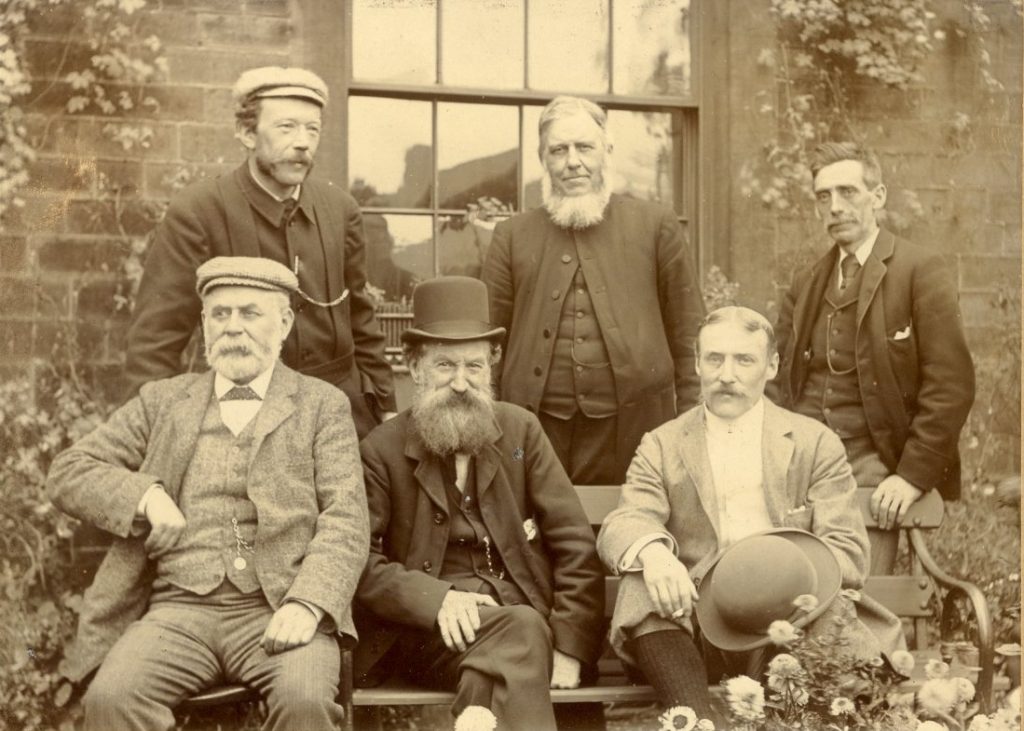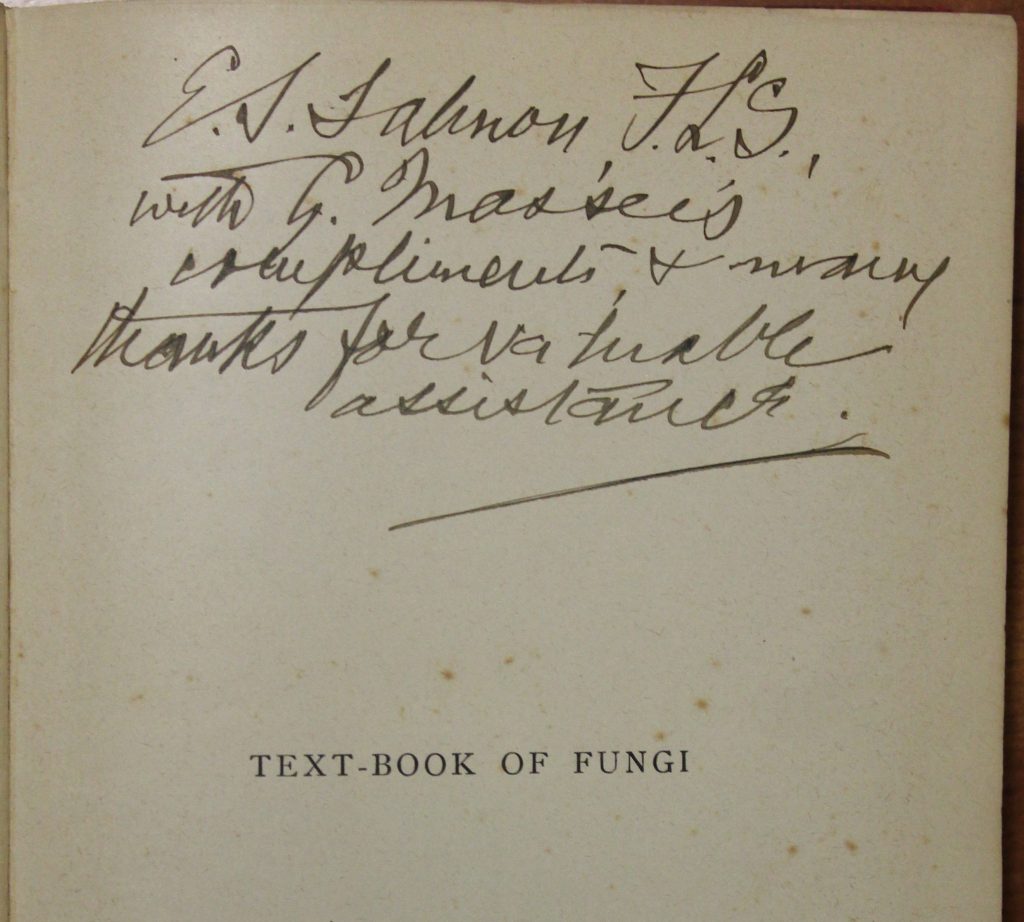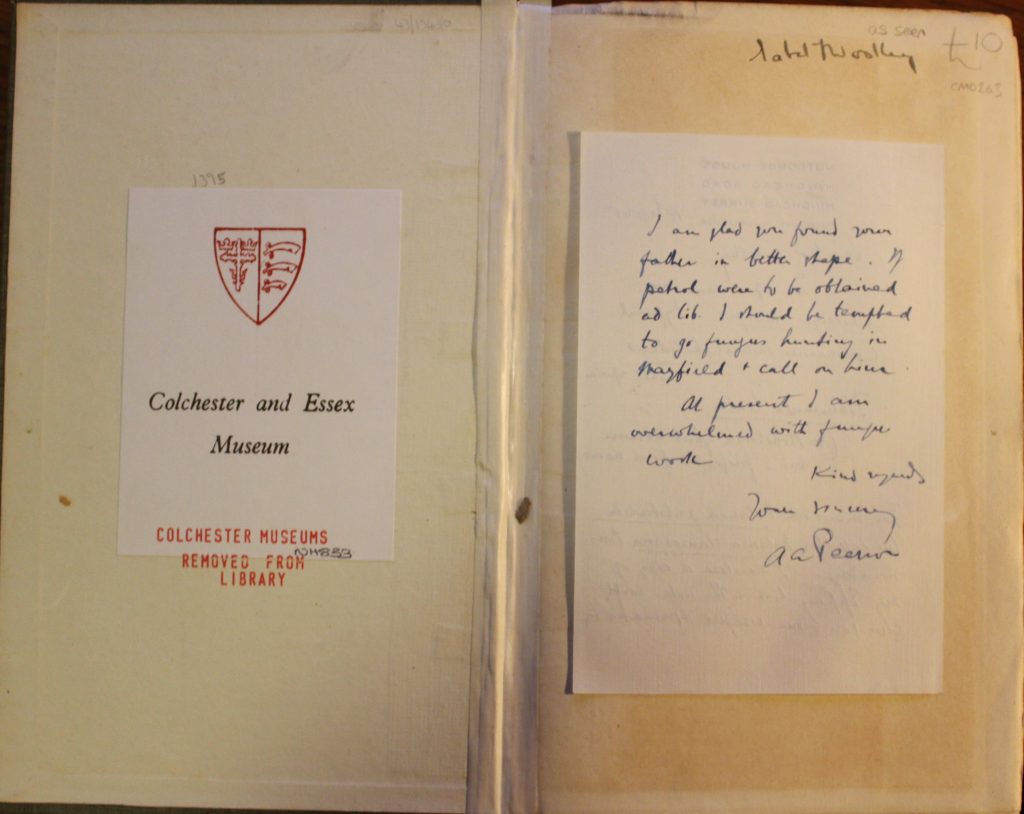
A Mycological Book Collection
Nathan Smith, runner-up in the 2019-20 Rose Book Collecting Prize, writes about his collection of books on fungi. For information on entering the 2020-21 Rose Prize (open to all current students of the University – entries are welcome until 29 January 2021), see here.
Mycology, the study of fungi, is an odd discipline. Neither an institutional monolith (like botany or zoology), ingrained in the structure of academic and public establishments, nor a minor discipline or field, confined to a niche subject area with a small number of followers and a smaller number of texts, it has instead existed as a science of the margins. It has maintained a strong amateur tradition, with expertise in the field often more likely to be found in the general public than in the universities and research institutions. Furthermore, it has been open to the extended and intimate involvement of women and those understood as within the working class throughout its history—but perhaps most prominently in its early establishment years.
Whilst lone individuals have always studied fungi throughout recorded history—even Aristotle and Pliny the Elder recorded opinions on them—mycology as a distinct discipline only began to organise itself in Britain in the second half of the nineteenth century. Before this, fungi were largely considered ephemeral curiosities and largely ignored by the scientific establishment—Linnaeus famously banished the fungi to the genus of Chaos in the 12th edition of his Systema Naturae (1767).
It was Rev. Miles Joseph Berkeley (1803-89), now considered the founding father of British mycology, who brought a level of scientific credibility to fungi. After the donation of Berkeley’s collection to Kew in 1879, the fist mycological position in Great Britain was established for its curation. This was given to Mordecai Cubitt Cooke (1825-1914) was appointed to curate the collection upon its donation to the Royal Botanic Gardens, Kew, in 1879. It wasn’t until the Woolhope Club Forays, first started in 1868, that mycologists began to regularly associate with each other, and in 1891 the first permanent mycological organisation formed (the Yorkshire Mycological Committee) was formed.

In 1896, with the Woolhope Club Forays recently consigned to history due to the death of its chief organiser, Dr Henry Graves Bull (1818-1885), a new mycological organisation was formed: the British Mycological Society (Fig. 1).[1] Despite the key role of Yorkshire Mycologists in its formation, peace between the two organisations was short lived. The first President of the British Mycological Society, George Edward Massee (1845-1917), left the fledgling society with a number of other mycologists in favour of the Yorkshire Mycological Committee, with the event serving as a catalyst for a bitter and protracted conflict that would last for over a decade and continues to shape British mycology to this day.
It was the urge to understand mycology as best as I could that first led to collecting mycological texts, as many are long out of print and have no digital equivalent. As my interests shifted towards the history of the discipline so did my collection, and I began to focus on books with unique provenance and extra textual features. My first serious acquisition was a copy of George Edward Massee’s British Fungal Flora (1893-5), a four-volume work and the last attempt by a single author to cover the entire breadth of Britain’s fungal diversity. These volumes are of particular note due to their provenance, having previously been owned by both William Bywater Grove (1848-1938), author of the oft-cited The Happy Fungus Hunter, and later by the curator, mycologist, and science populariser Ted Ellis (1909–86). All volumes are replete with substantial annotation and interleaving to the text, including additions of new specie and of other identification characteristics, rendering it a unique mycological relic, valuable as both a scientific and historic asset.
Other highlights of the collection include the Fungus Flora of Yorkshire (1905) and the Census Catalogue of British Lichens (1953), with both books being modified in their purpose by previous owners. The Fungus Flora of Yorkshire has become a diary of mycological finds across the UK, whereas the Census Catalogue of British Lichens has been transformed into a regional checklist for a nature reserve. A particular guilty treasure of the collection is a presentation copy of Massee’s Textbook of Fungi (Fig. 2; 1906) given to Ernest Stanley Salmon (1871-1959) for his help in assisting in preparing the work—all the more valuable due to the lack of written ephemera associated with Massee.

In preparing my collection for the prize, I found myself considering the books as distinct bibliographic objects, as opposed to carriers of mycological knowledge and history. Aspects such as the book’s publisher and printer, which I had previously been guilty of overlooking, became important features that furthered my understanding of the books I owned and the context of their existence. Fungi and Disease in Plants (1918), for example, was published by Thacker, Spink, and Co., the Calcutta branch of William Thacker & Co. The book’s author, Edwin John Butler (1874-1943), had been appointed the first Imperial Mycologist at Pusa, India, in 1906. The publisher of the book, in contrast to the primarily London-based publishers of earlier volumes, highlights both mycology’s growing stature and its increasing connections with the business of empire.
The collection has grown in small ways since its submission to the Rose Prize, largely limited by coronavirus (though the vanishingly small space on my bookshelf is also forcing restraint). I’m increasingly interested in the social dynamics of mycologists as they tried to navigate academic and amateur circles and pursue their craft in the borderlands of science. In this regard, my most exciting acquisition since the Prize is a copy of Carleton Rea’s British Basidiomycetae (Fig 3; 1922). A notable book in and of itself, the volume was the first published “under the auspices of the British Mycological Society” for which Rea had run for the first decades of its existence as a General Secretary, Treasurer, and Editor. In this, he was counterbalanced only by a yearly elected president—who on one occasion happened to be his wife! The volume in my possession, previously deaccessioned from a local museum, contains several letters from Arthur Anselm Pearson, an expert amateur mycologists and long-time treasurer of the British Mycological Society, to the book’s owner. The letters mix detailed mycological information, such as identification of samples, with personal enquiries. As such, they highlight the position of mycology throughout much of the twentieth century: an academically-marginalised discipline that was as much a social outlet as it was a scientific pursuit.

As I move forward with the collection, I am increasingly interested in disciplines, hobbies, and communities that were adjacent to mycology. Particularly, I have developed an interest in popular microscopy, a “healthful recreation” predominant Victorian era that saw similar efforts by amateurs to organise themselves and challenge the academic classes for scientific authority. Once more, books and periodicals played a central role as amateurs engaged in practices of publication in the pursuit of scientific legitimacy. Indeed, this central role of the printed word remains key as I shift between microscopes and mushrooms— a focus crucially enabled by my participation in the Rose Prize.
To close, it is perhaps worth noting that my collection has only been able to be established due to the consistent (and perhaps somewhat irresponsible) deaccessioning of scientific books from academic libraries. Here books on fungi, as well as other minority taxa, are particularly at risk, as the study of these organisms becomes increasingly absent from academic institutions. As the 2020 coronavirus epidemic pushes institutions further towards virtual infrastructures and eBooks, it is likely that such texts will be increasingly at risk of the mass sale, the charity donation, or, in far too often a case, the skip.
In such circumstances, particularly upon reflecting on the history of mycology as a discipline of the in-between, it feels as though the books in my collection maintain their original purpose. Passed down from mycologist to mycologist, they remain in active use as unique records of fungi and those who hunted them. They sit on my shelf, like the bolete after the first frost, in a quiet act of rebellion.
[1] The society was to be formally formed the next year). Image first published in Transactions of the British Mycological Society (Ramsbottom, 1915, page xiii). Top row, left to right: G. E. Massee, Revd W. Fowler, J. Needham. Bottom row, left to right: C. Crossland, M. C. Cooke, C. Rea. Photographer: Alfred Clarke. Reproduced by permission of the Tolson Memorial Museum, Huddersfield.

I have J Ramsbottom’s Authors annotated copy of his book- Handbook of the Larger British Fungi publ British Museum Nat Hist in 1923. Every printed text page is faced with a blank page where he has written copious additional notes to supplement the printed text. There are also newspaper cuttings and pamphlets of mycological interest added into the book.
I have had this book for over 40 years and it cost me £45 to purchase.
Do you think anyone would be interested as it is a unique mycologist memoir which should be kept for the future?
Thank you
Thank you for your comment. I think your copy is probably very interesting. You might like to approach the Natural History Museum about it (https://www.nhm.ac.uk/contact-us/forms/emailform.jsp?recip=library&business_title=Library+and+Archives&email). Best wishes, Liam Sims (Rare Books Specialist)